Life After ISIS
Visiting Mosul and HatraLife After ISIS: Visting Mosul and Hatra
Last updated: 4 Sep 2022.
During the final assault by US-backed forces to retake Mosul from ISIS in 2017, I happened to be in Bashiqua, a village 20 km away. This was completely by accident – I’d booked discounted flights to visit Iraqi Kurdistan three months earlier, when everything was still fairly normal. At that point, a lot of territory that had been recaptured by the Kurds from ISIS, had been temporarily incorporated into the Kurdish region, so I was able to visit areas with my Kurdish visa-on-arrival that are now firmly off limits without a full Iraqi visa.
When I was in Bashiqua, I remember seeing dark smoke rising from Mosul in the distance and wondering what the city was like. I’ve since read a fascinating and horrific account of a Yazidi girl who was captured and enslaved by ISIS (The Girl Who Escaped from ISIS by Farida Khalaf and Andrea C. Hoffmann, which I would thoroughly recommend), and I’ve been curious to visit Mosul ever since.
Visiting Mosul can only be described as dark tourism, in that the main interest comes from the darkness of the past few years under ISIS control and the devastation that is still highly visible throughout the city. That said, local Iraqis are generally keen to see tourists return to and the local economy could definitely benefit from the tourist dollars.
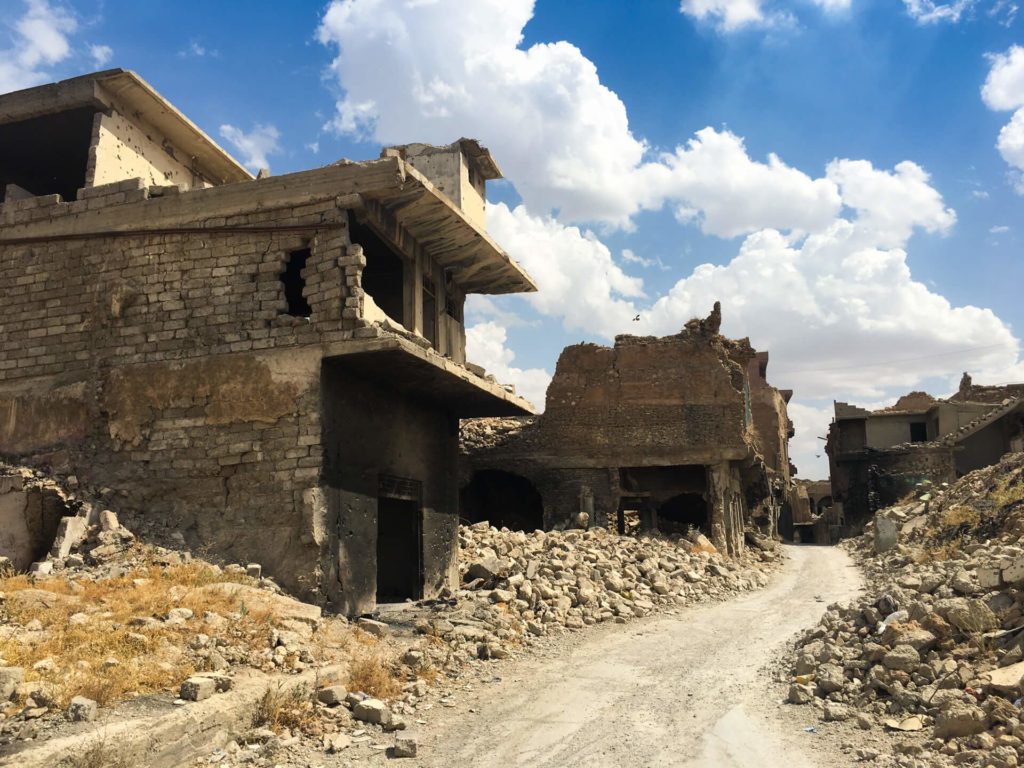
The deserted ruins of the old town of Mosul.
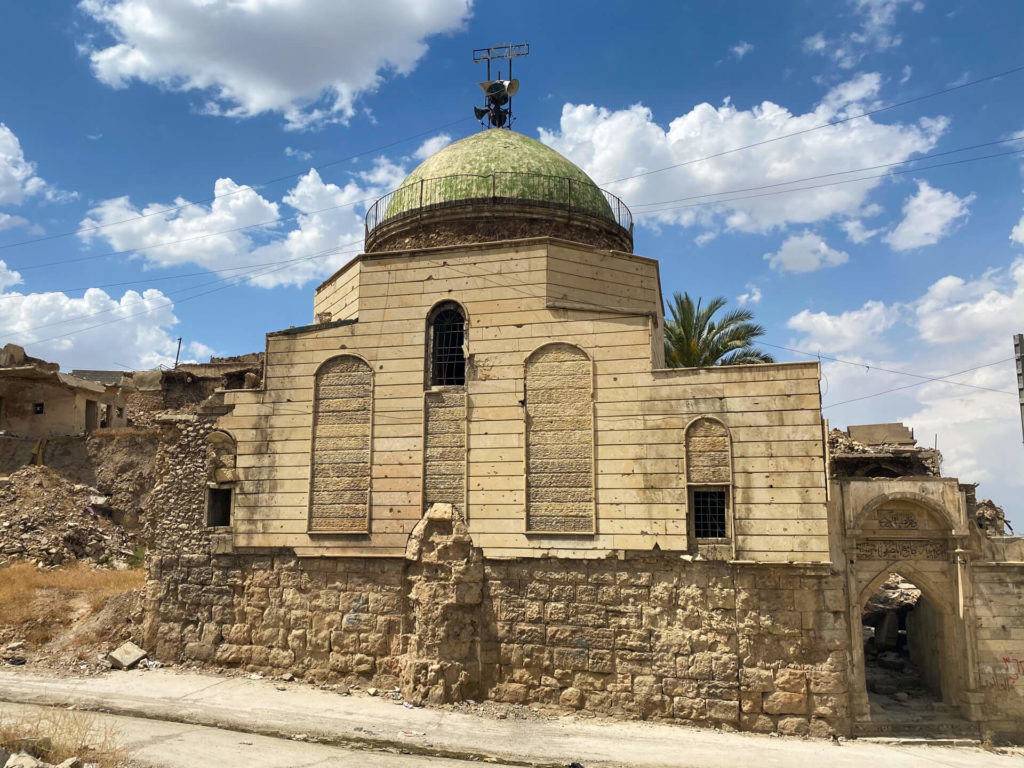
The Umayyad Mosque, the oldest mosque in Mosul, which amazingly escaped the worst of the destruction.
The Road to Mosul
We travelled to Mosul from Kirkuk by shared taxi. A friend told us to catch the shared taxi at Garage Baghdad, where shared taxis depart to Baghdad, but when we arrived the very friendly taxi drivers told us we were at the wrong garage – the one for Mosul was 3km away across the city. We negotiated 3k IQD for a driver to take us there, but just as we were about to depart, another driver appeared and told us that he just happened to have another couple of passengers heading to Mosul, so we could go with them. Our luck was good, as usual!
The journey took about four hours and the road passed through a thin sliver of Kurdistan that lies between Kirkuk and Mosul. We’d heard that the checkpoint to enter Mosul could be problematic for foreigners, but actually the longest delay came when entering Kurdistan. The Kurdish soldiers were friendly enough, but didn’t speak any English, and insisted that we phone an Iraqi friend to interpret for us. Eventually, we got back on the road and the one to enter Mosul turned out to be a breeze.
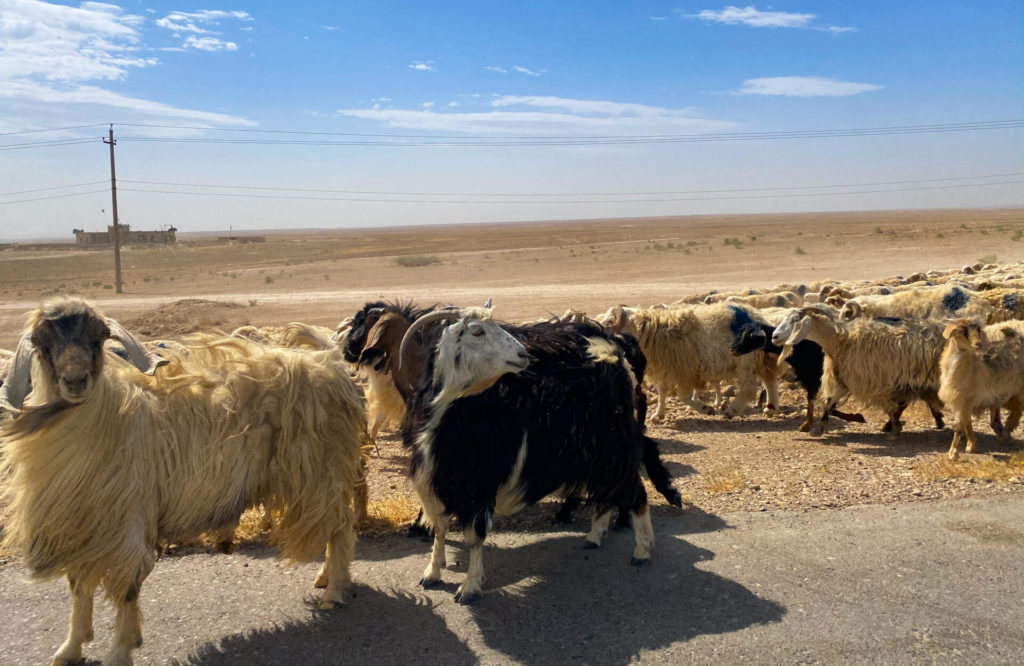
A heard of very photogenic sheep by the edge of the road outside of Mosul.
Our shared taxi left us by a roundabout on the edge of Mosul, where a group of taxi drivers all wanted to take us to our hotel. We bargained the price from 5k to 4k IQD and then randomly chose a driver and followed him to his taxi. However, another driver felt that this was unfair and the next thing we knew they were pushing each other in a fight over whose taxi we would take. At that moment, another opportunistic driver pulled up and shouted, “Get in!” So we did.
When the drivers who were fighting realised that we were leaving, they tried to pull the taxi door open, so I held it shut and shouted to the driver to drive, and off we went. Part way through the journey, we realised that our driver only had one leg, so no wonder he wasn’t on the street fighting with the others. He told us he’d lost the other one to an American bomb. We gave him the full fare without bargaining.
Exploring the New Town
The first afternoon in Mosul, we had lunch in a random kebab restaurant that was open despite it being Ramadan. The staff were super friendly and took selfies with us. We felt that we were wasting quite a lot of food in Iraq, because the portions are huge, so we tried to order just a small amount. Somehow, as usual, that got lost between the language barrier and the Arab hospitality. The kebab was actually about right, but they came with a mountain of (delicious) side dishes.
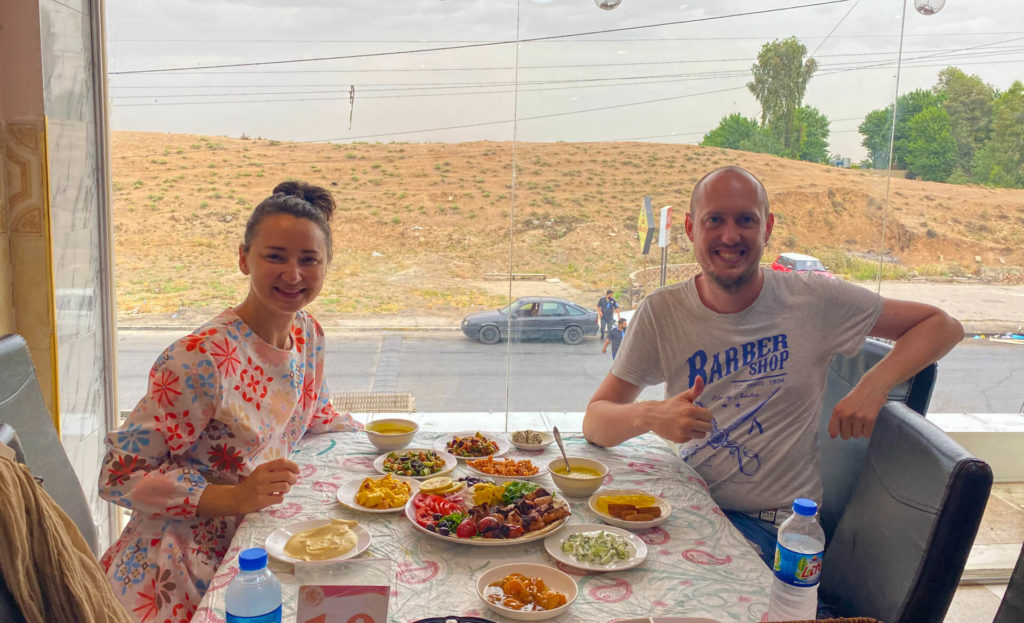
A $4 dinner in Mosul. The number of side dishes blew us away!
We did our best, but as usual there was no way we could finish it all. And when the bill came – it was 6k IQD, about $4 for the two of us! Apart from hotels, probably because there aren’t many, Mosul was the cheapest city we visited during our whole time in Iraq.
After lunch, we tried to visit the Mosque of Prophet Yunus, but it was closed. However, we had a nice walk through the city and chatted with a few locals near the mosque. “You need a permit from the relevant government department to enter,” they told us. The security presence was high, but everyone was very friendly. We noticed an unusually large number of amputees – a sad reminder of recent events. We wandered around the local market and bought some delicious Iraqi sweets on the way back to the hotel.
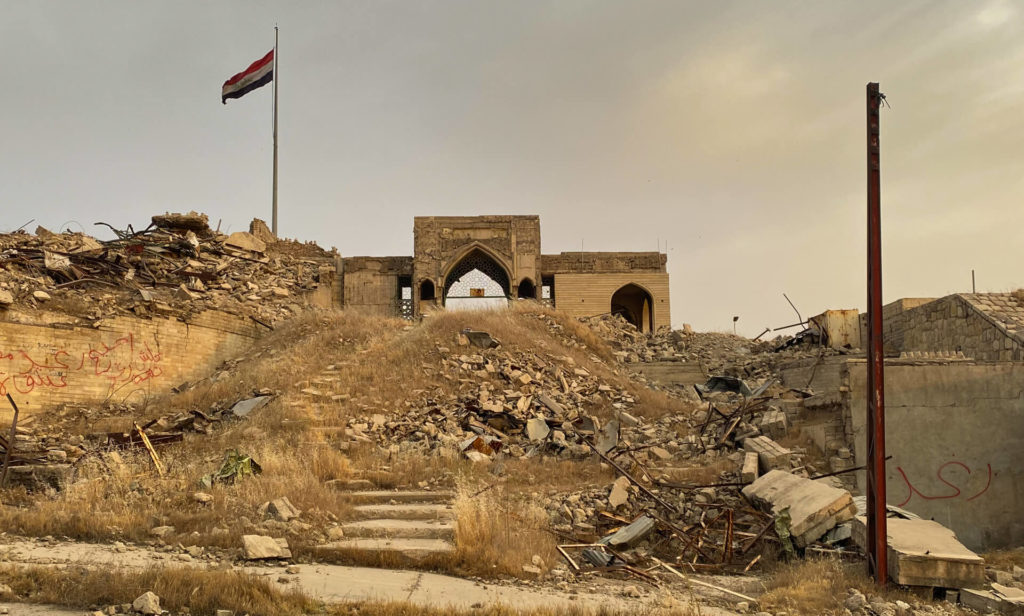
The entrance to the Mosque of Prophet Yunus.
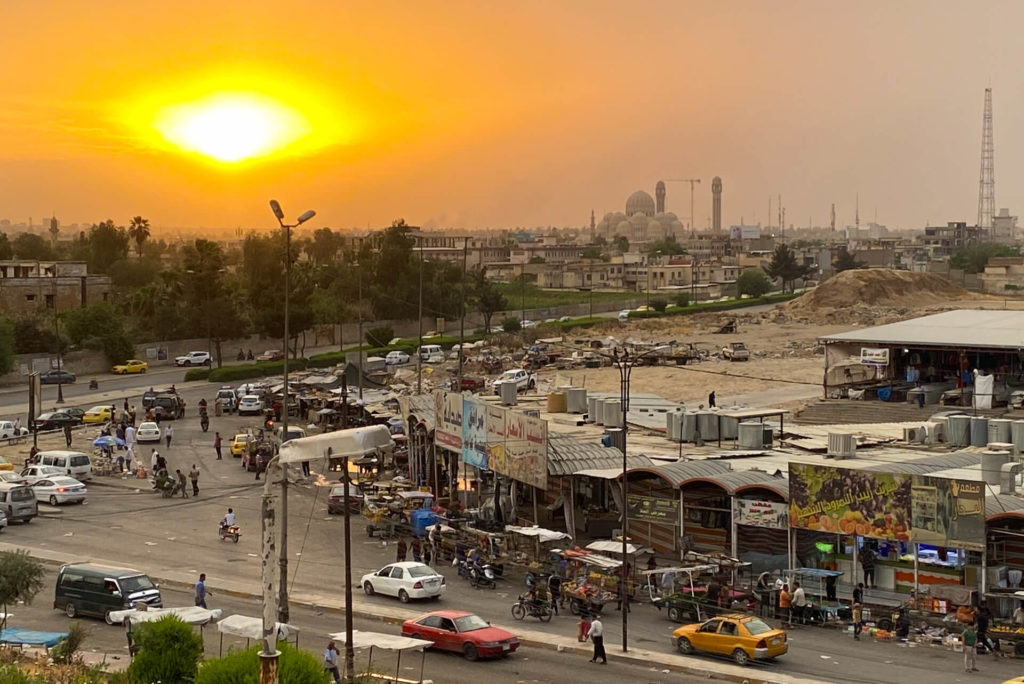
The sun sets of a local market in Mosul, viewed from the entrance to the Mosque of Prophet Yunus.
Mosul Nightlife
Mosul is not Beirut and I’m not talking about all-night parties here. In the evening, Anna decided to stay in with a good book and I went out with Mohammed, a local Couchsurfer I’d been in touch with. We went first to an ice-cream parlour and I was surprised by the relaxed vibe.
Like many Middle Eastern countries, in many areas of Iraq guys socialise freely in the evenings, but girls stay at home out of sight. Mosul was different. There were a couple of groups of girls at the ice cream parlour, some in hijab and some without, chatting and laughing together. It was a refreshing sight.
Mohammed and I had a very nice ice cream and then went for a drive. He took me to take some selfies by the “I love Mosul” sign. Then we went to smoke shisha and drink fresh juice. The shisha place was stylish and had a friendly vibe. Many Iraqi guys (and this place was all guys) enjoy hanging out in such places in the evening, chatting and playing cards or backgammon.
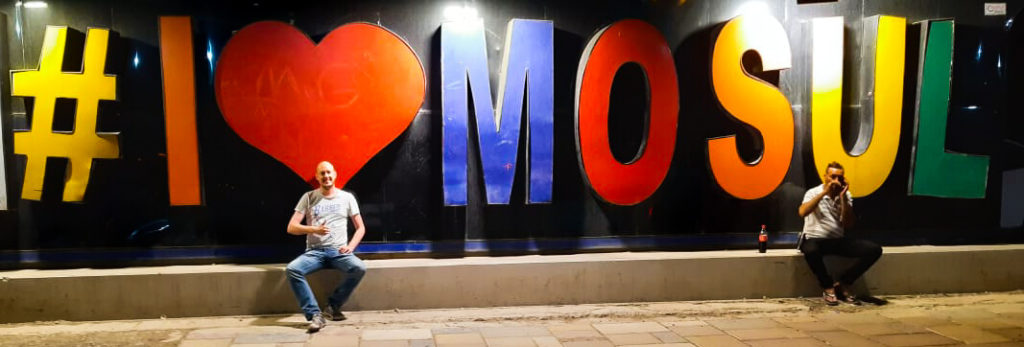
The I Love Mosul sign, awaits the tourist hordes
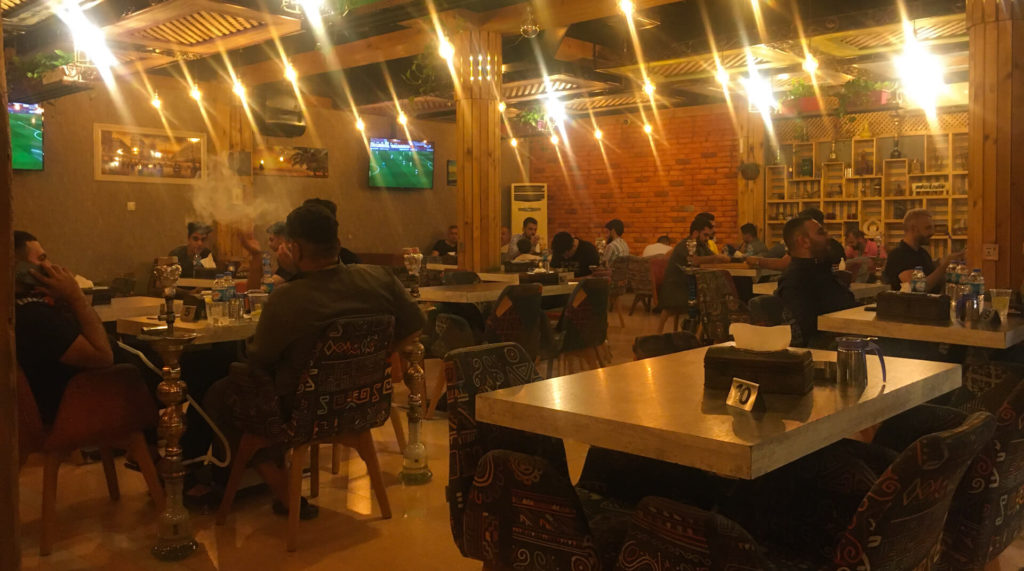
Hanging out at a local shisha joint with Mohammed.
While we were chatting, I got a call from Xavi, a young British guy I’d been in touch with through EPS, a Facebook travel group. He’d been hanging out in Mosul with a group of university students for a couple of weeks and the next day they were going to Hatra, so he asked whether we wanted to join them. I’d heard about Hatra, an ancient city to the south of Mosul, from a few Iraqis. They’d all recommended visiting it, but it’s on the edge of a desert still crawling with the remnants of ISIS and completely off-limits to Iraqis and foreigners alike. It turned out that one of Xavi’s friends was really well connected – we were lucky again!
The Ancient City of Hatra
The next morning, Othman, a friend of Xavi’s, picked us up from the hotel at 4:30am. Before heading to Hatra, we stopped at a couple of other sights in Mosul and met up with the rest of the group. There were about 12 of us altogether.
The first stop was a ruined bridge across the Tigris river, which cuts right through the middle of Mosul. The middle of the bridge had been almost severed by bombs during the fight with ISIS and a temporary mettle structure had been erected over the gap to allow cars to pass. Our new friends told us that to escape ISIS, some families had scrambled across the twisted metal rods that had been exposed like tattered sinews still connecting the two sides. Whole families crossed, children and all, babies balanced precariously in their parents’ arms.
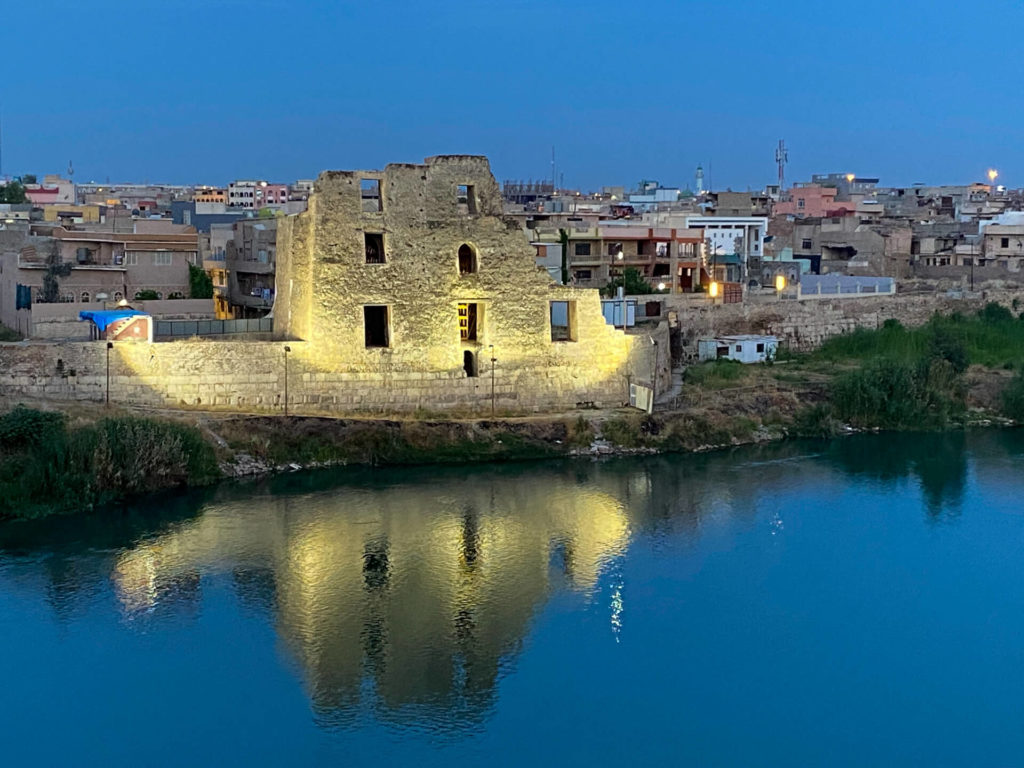
The banks of the Tigris in the early morning light were quite picturesque.
We crossed the bridge and drove to the ruins of the ancient Bashtabya Castle, built in the 12the century, which stands on the banks of the Tigris. The ruins were damaged both accidently by missiles during the conflict with ISIS and deliberately by the militants themselves, who tried to blow up the remains in 2015. It’s quite a mess, with turrets visibly sliding down the banks of the Tigris, but pretty nonetheless. We climbed to the top and enjoyed the views over the city at sunrise, as the sky turned a beautiful pink.
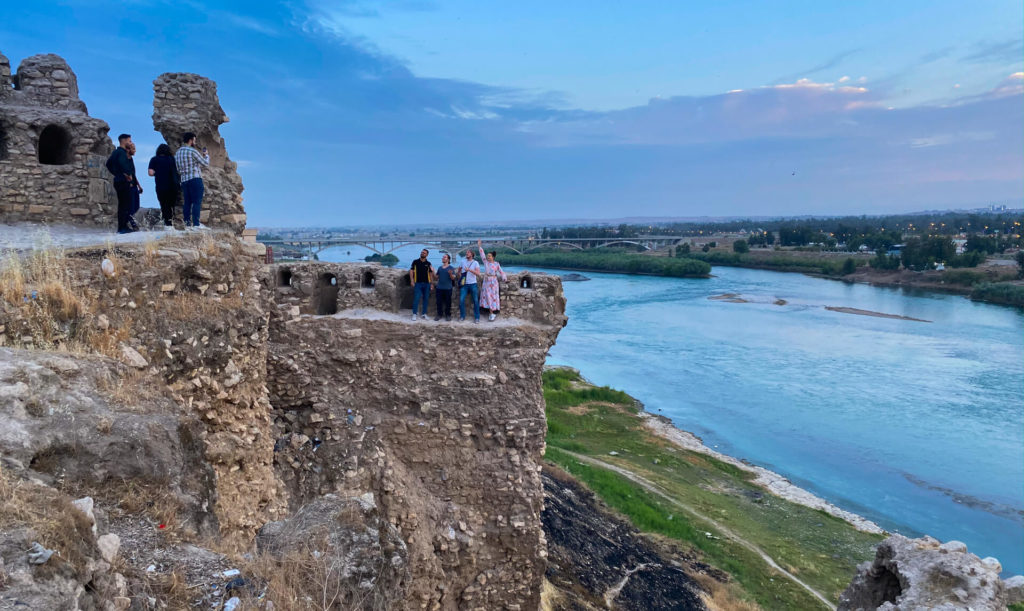
Selfies on the ruins of the Bashtabya Castle.
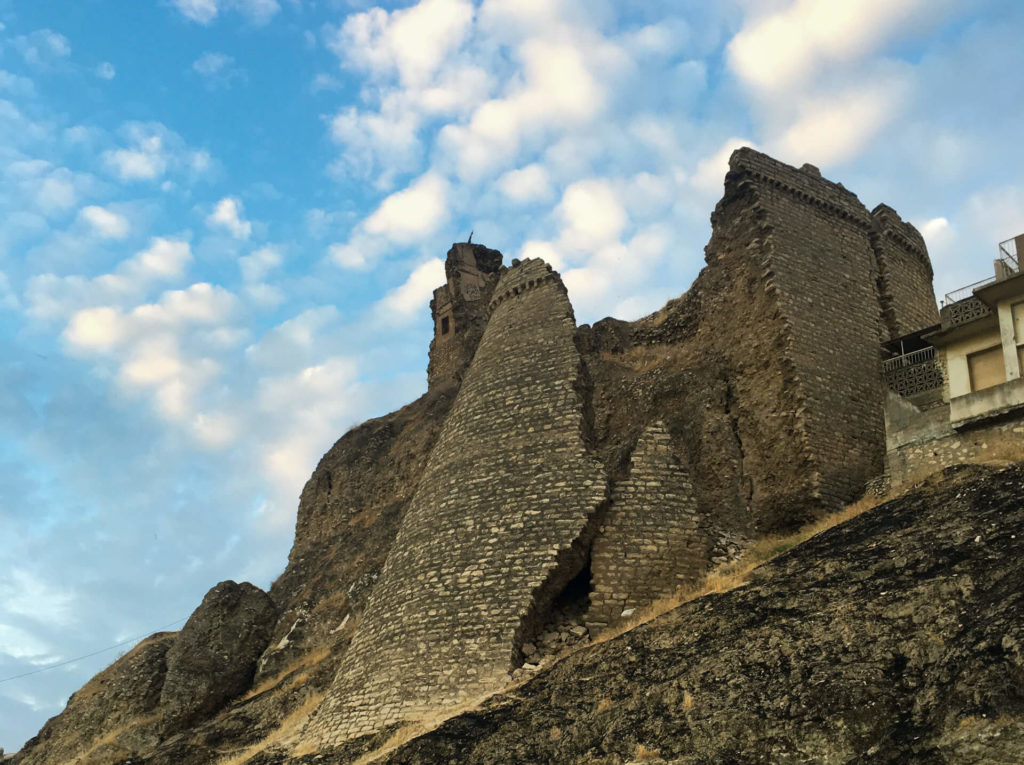
We walked a little way along the banks for the Tigril below the Bashtabya Castle. It looks as though it’s turrets are gradually sliding down the hillside towards the river.
Soon, we were back in the cars and speeding south from Mosul towards Hatra, about 110km away. We sailed through the checkpoint at the entrance with minimal hassle. When ISIS had Mosul, they dug trenches every couple of hundred metres along the road (which is the main road to the city from Baghdad) to prevent attacks from that direction. The trenches have since been filled in with tarmac, but the patching is a bit rough and it made for a bumpy journey.
Eventually, our little convoy turned onto a rough road leading into the western desert. Over the next few kilometers, we stopped at about three military checkpoints and then a final one to enter the ancient city of Hatra. After some delay, the guards waved us through and we arrived at the gates of the 2,000 year old capital of the Kingdom of Hatra. The kingdom was ruled by Arab princes and was once an important religious center along the caravan trails that ran through Mesopotamia.
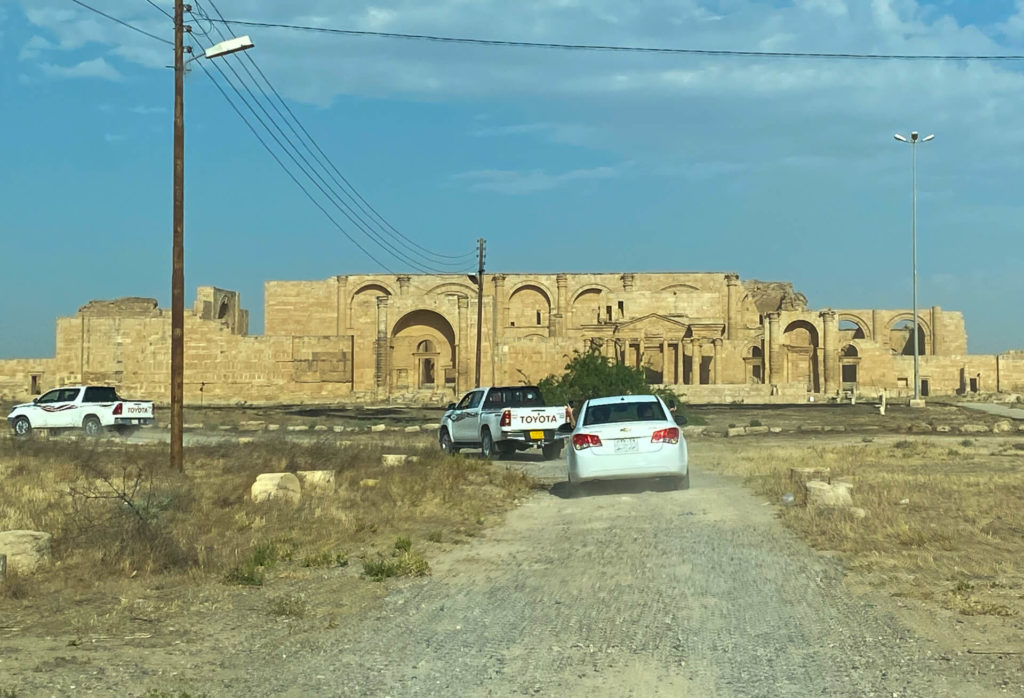
Tearing through the desert towards Hatra.
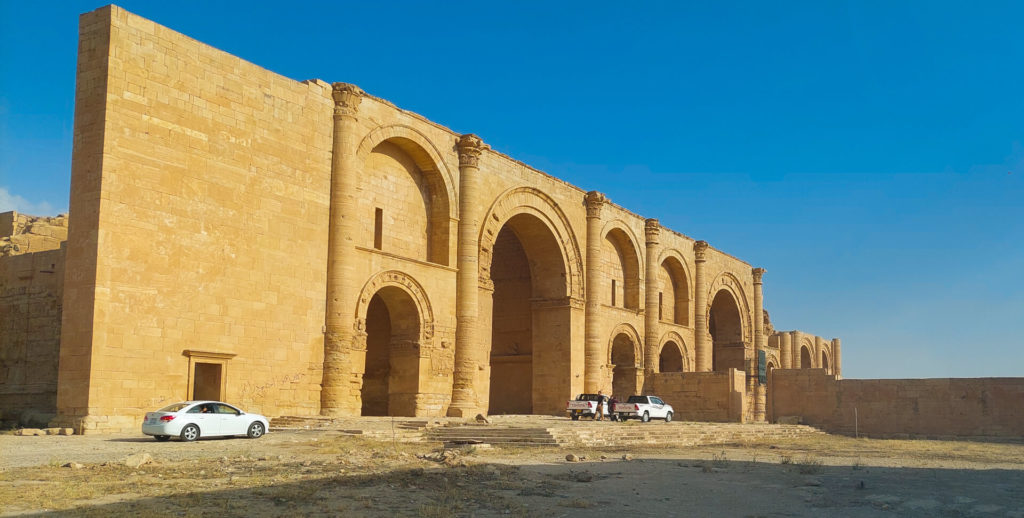
We parked out front of Hatra’s main building.
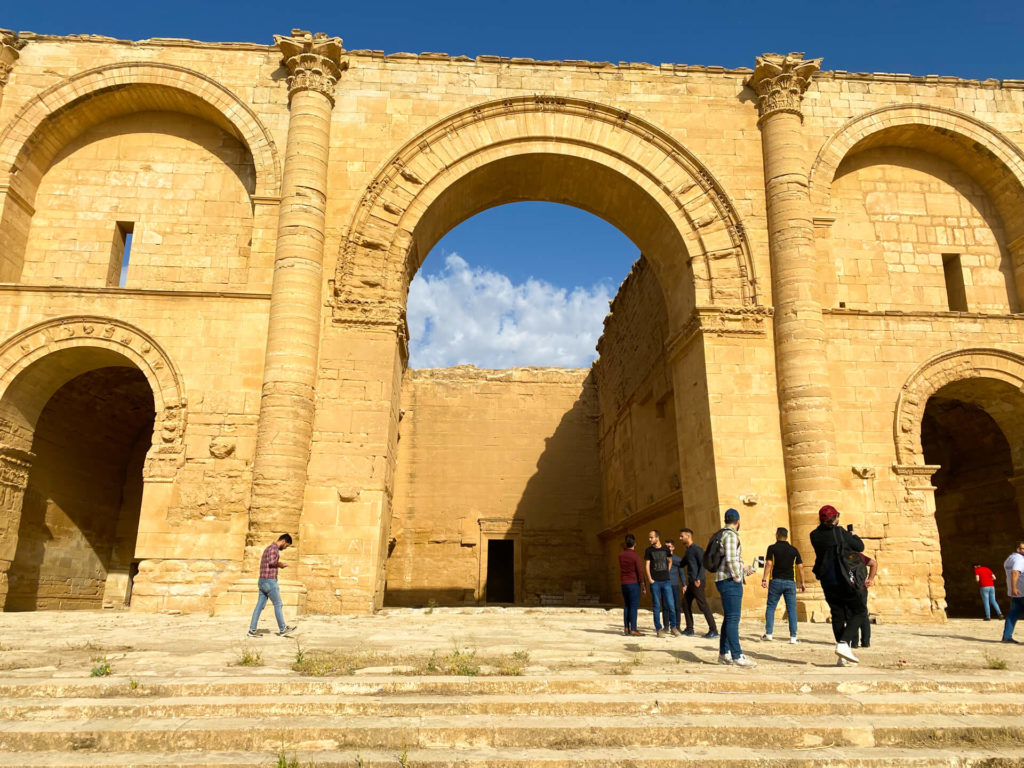
The main facade was beyond spectacular.
For a two-thousand-year-old ruin, Hatra is in extremely good condition and we couldn’t help but marvel at the magnificent stone arches soaring above us. Surprisingly, ISIS did only minor damage, beheading a few statues here and there. We explored the vast and impressive ruins, wandering through dark corridors and admiring towering Romanesque pillars. At the side of the main building, we found a staircase leading up to the top and were able to climb onto the roof of the main building. Like from the Malwiya Minaret in Samarra, the view was of endless flat desert stretching to the horizon in all directions.
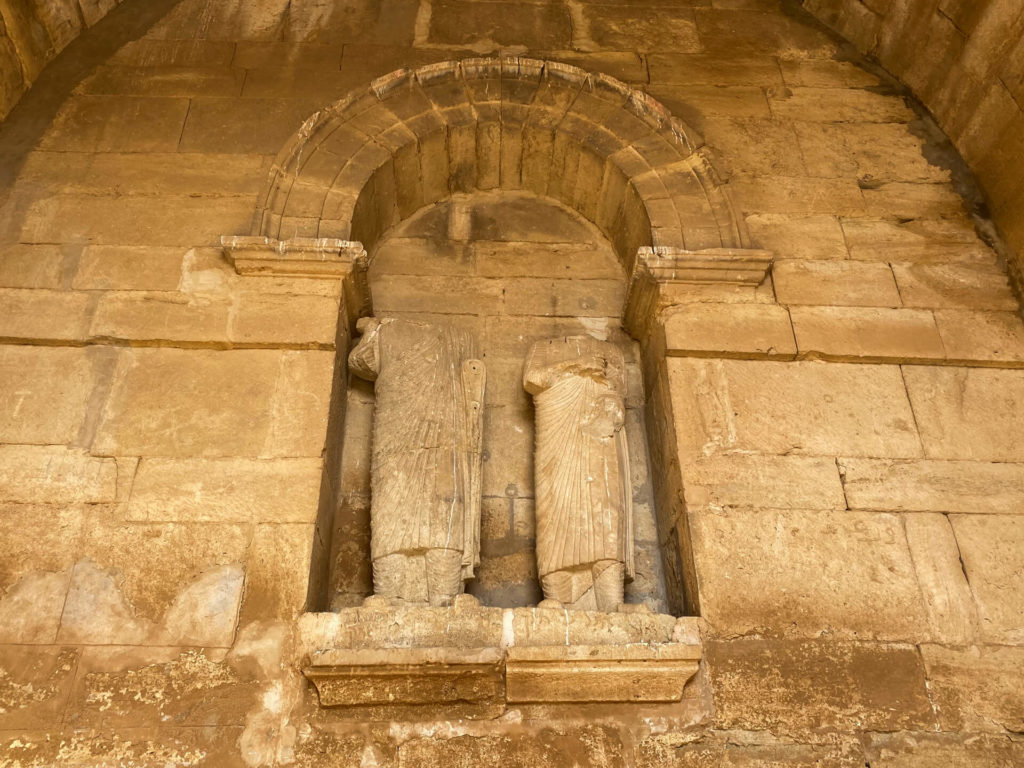
ISIS beheaded a few statues, but otherwise the damage they did was fairly minor.
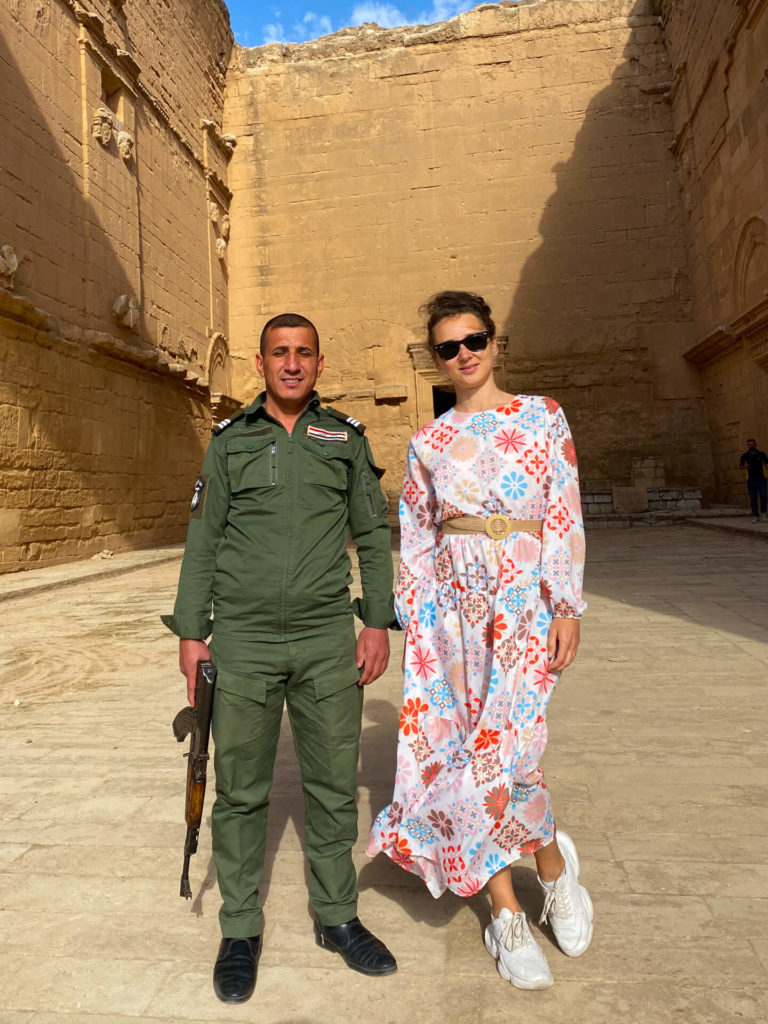
Anna poses with one of the soldiers tasked with guarding the ancient city.
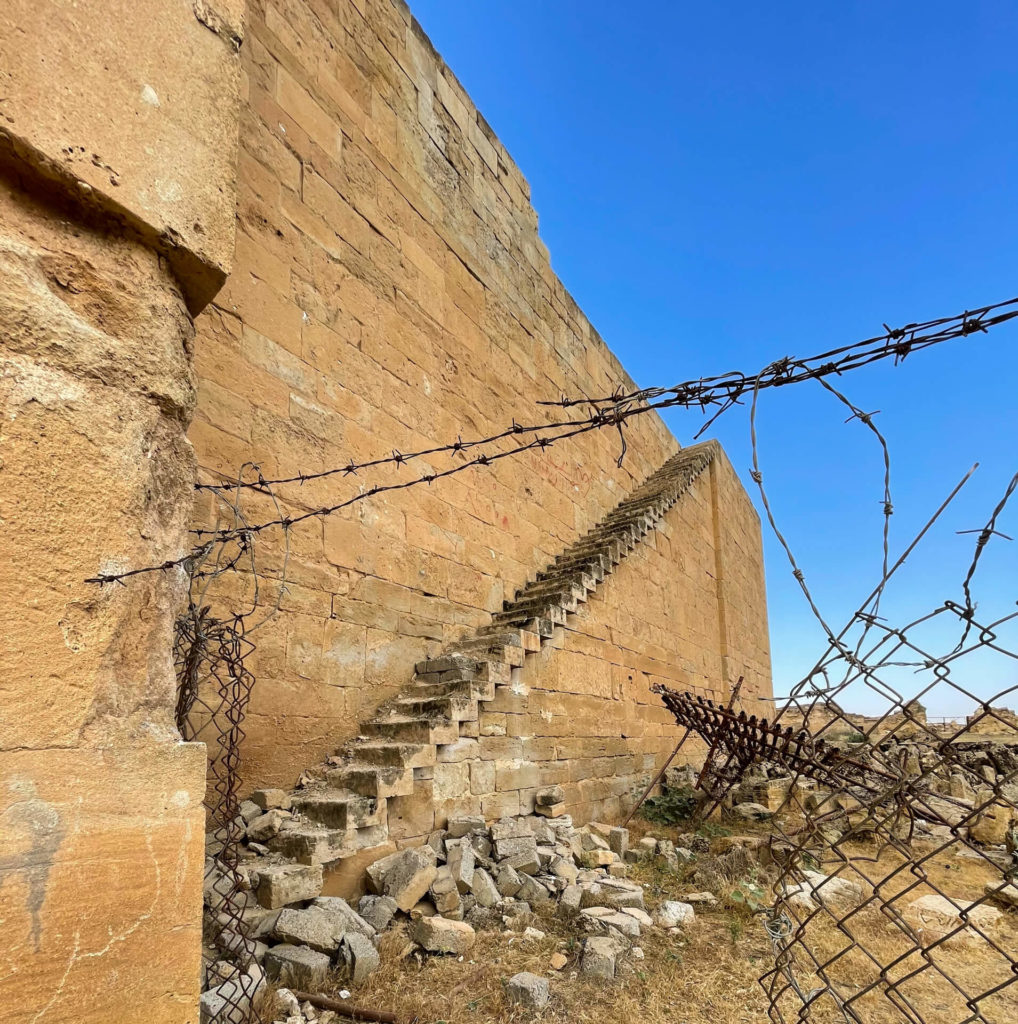
We climbed through a hole in the back fence to reach the secret side-staircase to the rooftop.
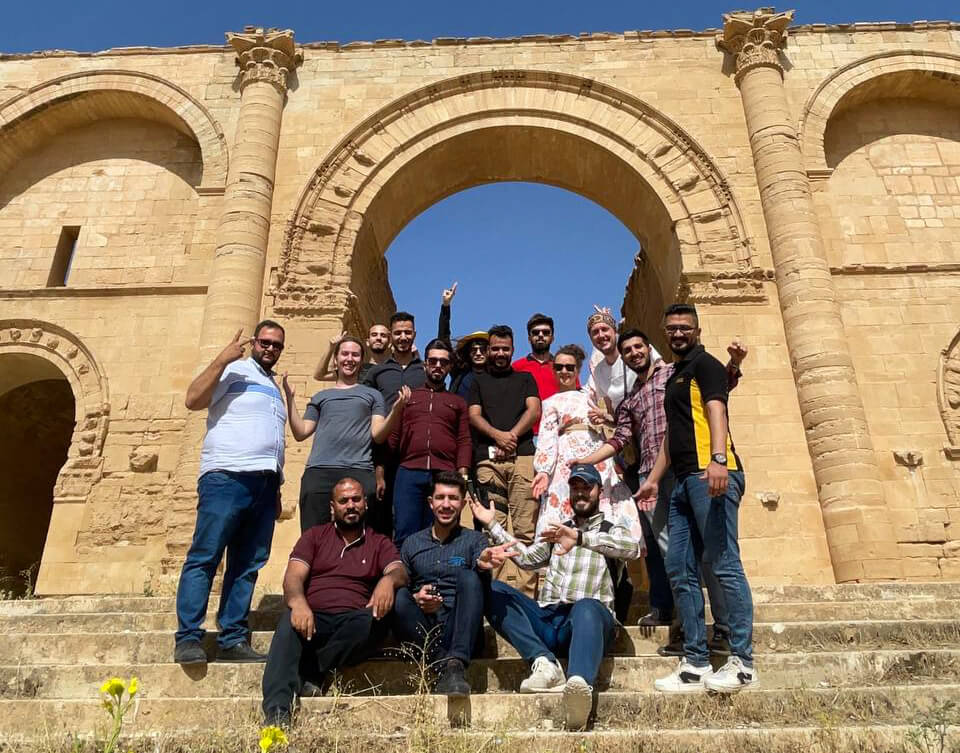
Final group selfie before we depart, courtesy of our friendly soldiers.
After about an hour or so, the guards told us that our time was almost up. One of them was particularly friendly and took a group of us around to the desert at the side of the ancient city. The conversation was in Arabic, so I wasn’t sure what we were doing until we got there – one member of our group had asked to try firing the guard’s pistol. After he fired it, I asked if I could have a go. I’ve fired deer hunting rifles and shotguns before, but handguns are rare in the UK, so I was curious to try.
The guard looked a bit unsure about giving his gun to a foreigner to start with, but then decided that I looked harmless enough. He inserted the clip, loaded a single bullet into the chamber, and removed it again. “Aim high, so the bullet doesn’t ricochet,” he said and showed me how to brace my hands against the gun’s kick. I aimed high across the desert and fired. The kick surprised me for such a tiny weapon, as did how little sound it made.
We took a group photo and piled back into the cars. Back in Mosul, a group of us who weren’t fasting for Ramadan went for a delicious meal of qouzi (lamb) and other Iraqi delicacies and then Anna and I headed to the old town. By this point, we’d got to know Othman pretty well and he decided to join us for the adventure.
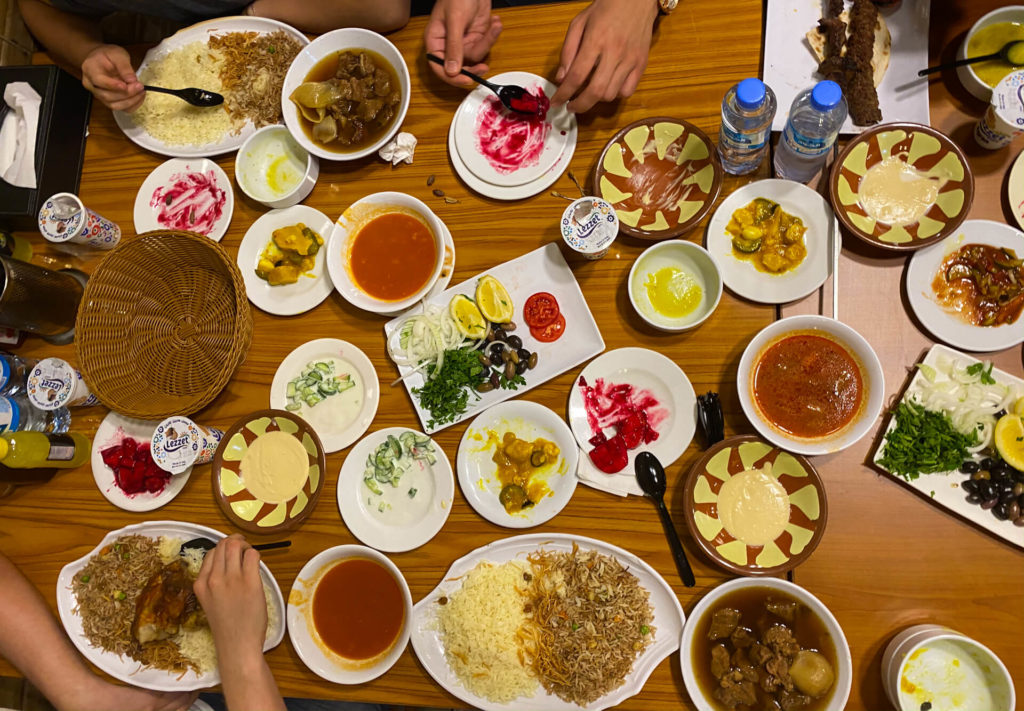
An amazing lunch. We couldn’t finish it, as usual, despite being up since 4:30 am.
The Ruins of Mosul’s Old Town
Mosul is divided into two halves, known as the left and right coasts, by the Tigris river. The right coast, where the old town is, is generally more interesting and was the worst affected by ISIS. However, the left coast is generally considered safer, so we’d elected to stay in a hotel there. We had read some warnings from other travellers about some dodgy characters around the old town, but we had no problems at all and everyone we met was extremely friendly.
Othman dropped us near the old town while he went to the mosque for afternoon prayers. While he was praying, we took some pictures by a few very picturesque, almost European-style, shops. A friendly soldier came over to talk to us, but unfortunately we had no idea what he was saying. We just knew he was friendly from his smile and tone of voice.
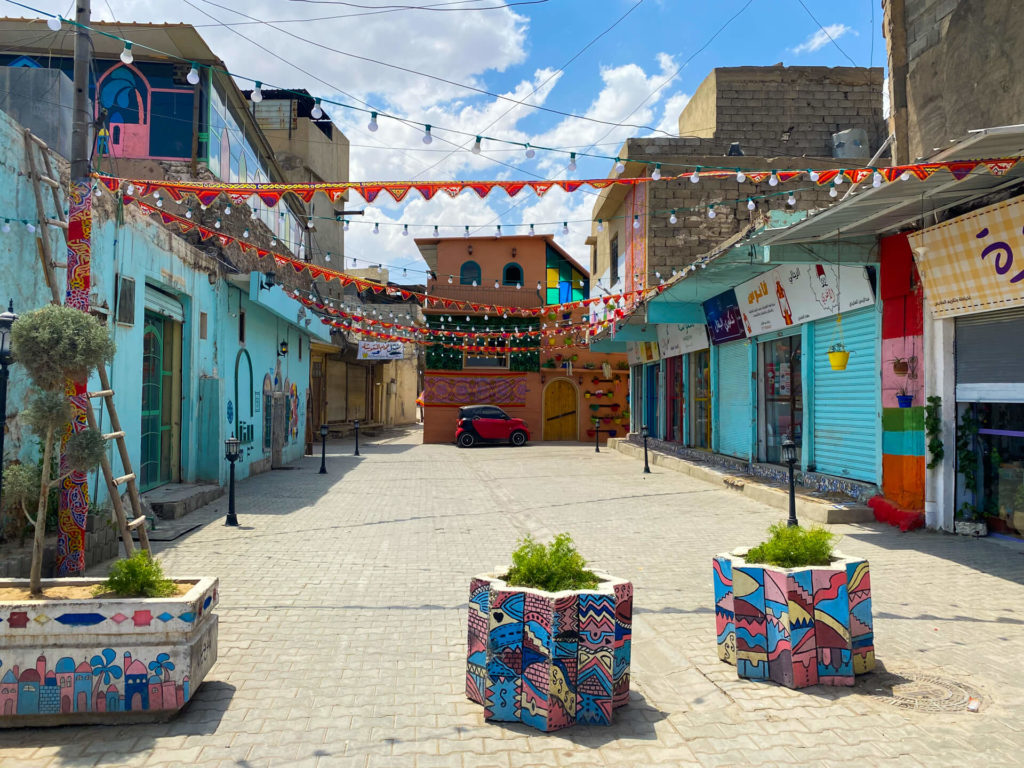
The hipster part of Mosul
We then wandered into the old town, coming almost immediately to the remains of the iconic Al-Hadba (“the hunchback”) leaning minaret, which appears on the 10,000 Iraqi dinar note. Renovations are ongoing, but all that remains currently is a stump, since it was blown up by ISIS in June 2017, just before they were defeated. The Iraqi prime minister at the time called the act ISIS’s declaration of defeat.
Going deeper, we wandered a series of alleys and small streets, noting here and there that some houses had been destroyed and others were badly damaged. However, this was nothing compared to what was to come. Political graffiti covered some of the walls and residents occasionally flitted in and out of houses, although it was fairly quiet at midday. Then we crossed a road and there was an immediate change. Buildings lay in ruins, roofs had collapsed and most of the houses had been abandoned.
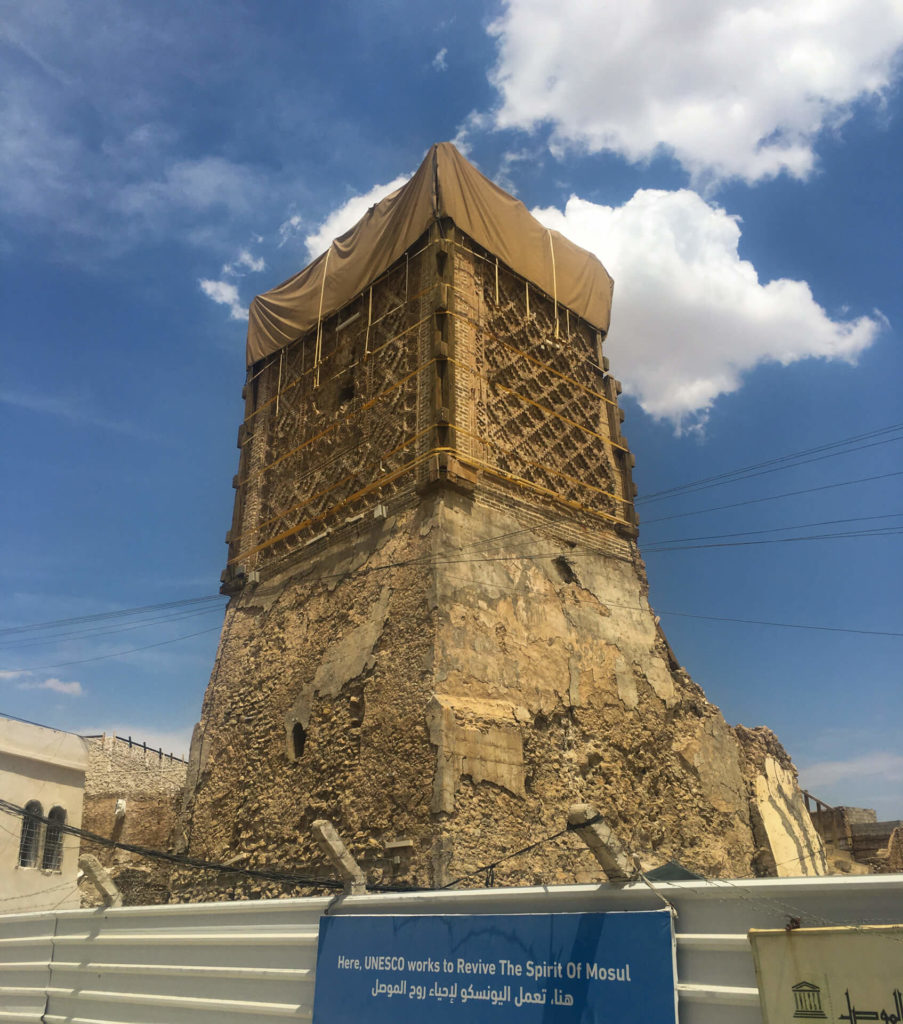
The remains of the “hunchback” or, more formally, the Al-Hadba leaning minaret.
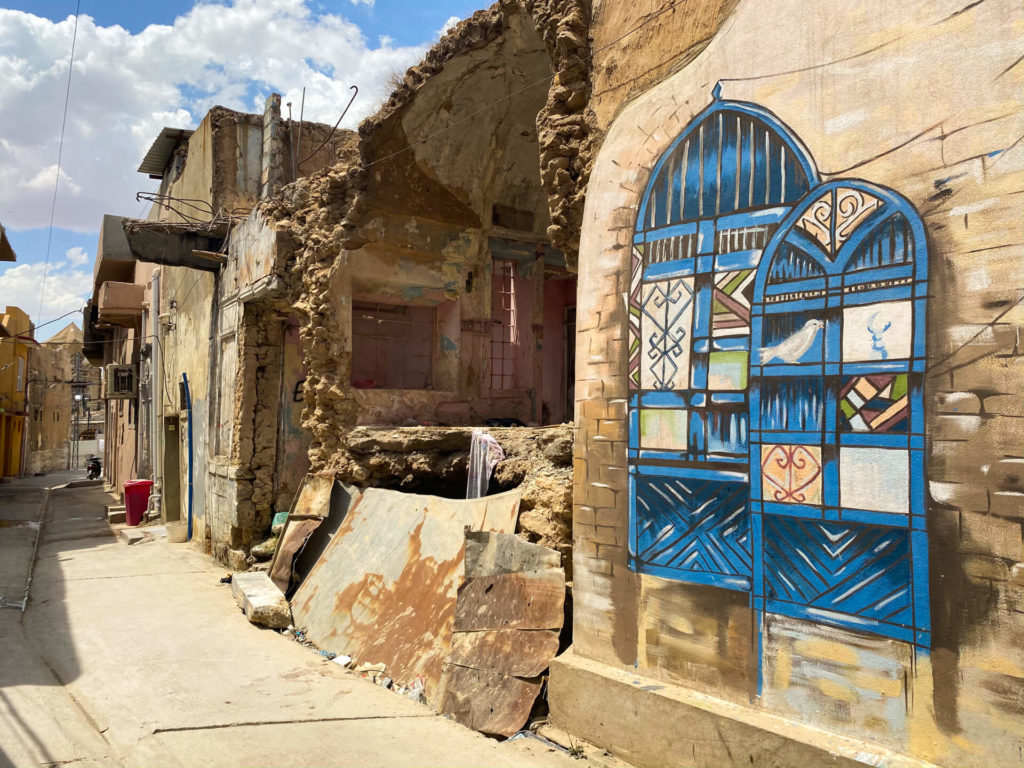
Wandering the street of Mosul. Some of the graffiti is quite pretty.
We walked up a slight hill and came upon the remains of the old and once beautiful Al Tahira church (this part of Iraq has a significant Christian population). The walls were riddled with bullet holes and rubble was strewn across the floor. Some of the walls had been destroyed and the roof looked decidedly unsafe. We clambered through the rubble and the dust and stared in wonder at the destruction before us. There was an eerie beauty to it and, to spectators like ourselves who’ve never experienced war first-hand, a fascination at the destruction that had been wrought. There was no one around and we took photos at our leisure, trying to avoid standing under the most unsafe-looking parts of the roof.
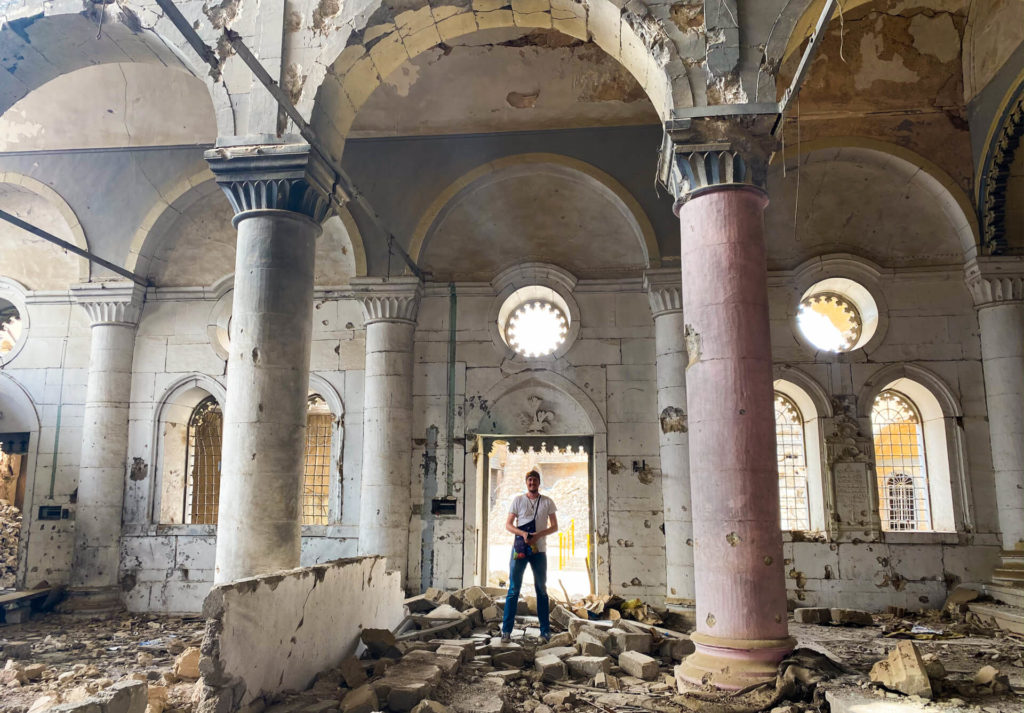
Standing among the ruins of the badly damaged Al Tahira church in Mosul.
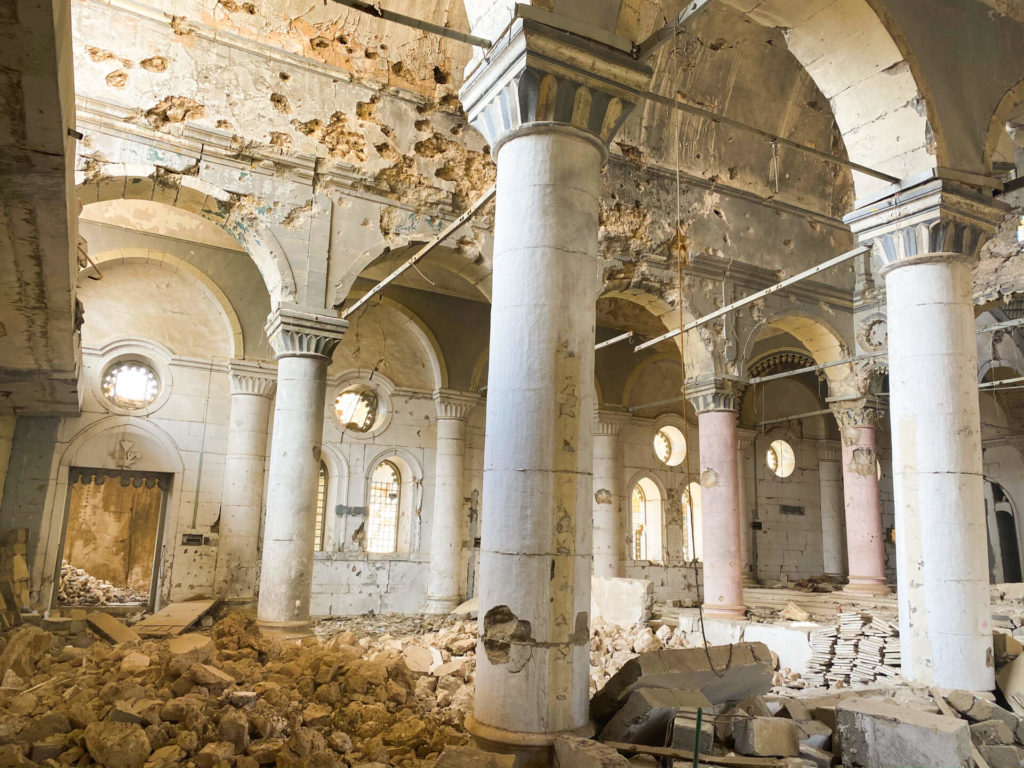
The walls of the Al Tahira church were riddled with bullet holes.
By this stage, Othman had finished his prayers and came to join us. He told us that the soldier who’d tried to talk with us earlier was only concerned about our wellbeing and wanted to ask if we needed any help. We knew he was friendly! The three of us spent most of the next two hours wandering the ruins of this historic city.
The scale of the destruction is hard to comprehend – street after street lined by the ruined carcases of beautiful old buildings that had been rendered uninhabitable by US bombing. At the heart of the old town, practically every house had been abandoned. ISIS had surely done some damage, but compared to US air power, their weapons were relatively small. This is not to say that the US shouldn’t have bombed, the bombing campaign was surely instrumental in driving ISIS out, but locals we spoke to were told over the issue, with many families having lost their homes in the destruction.
I helped with the cleanup of Beirut after the port explosion there in August 2020 and saw firsthand the destruction, but that (although tragic, especially in terms of how easily could’ve been avoided) was nothing compared to this. House after house lay in ruins, rubble piled high, ancient archways collapsed into the dust.
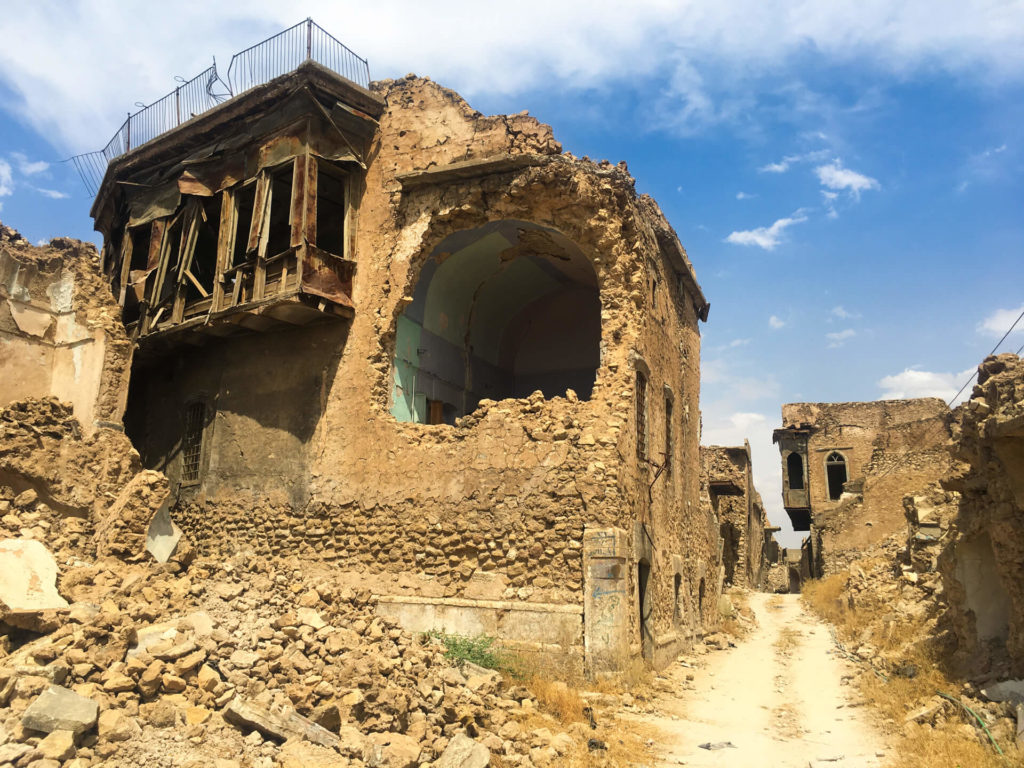
Destruction on a massive scale – practically none of the buildings in the old town are still inhabitable.
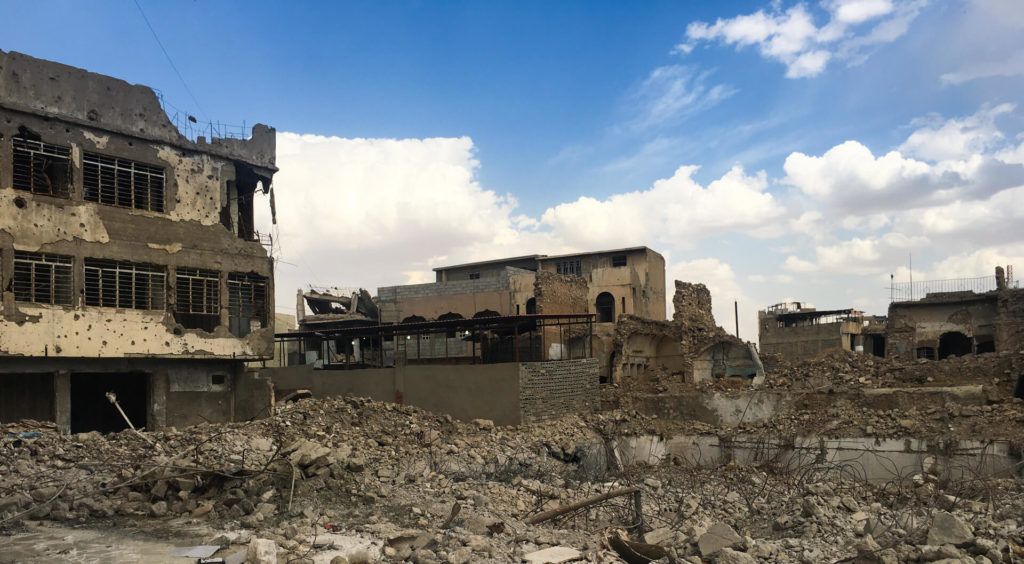
The mangled husks of destroyed buildings.
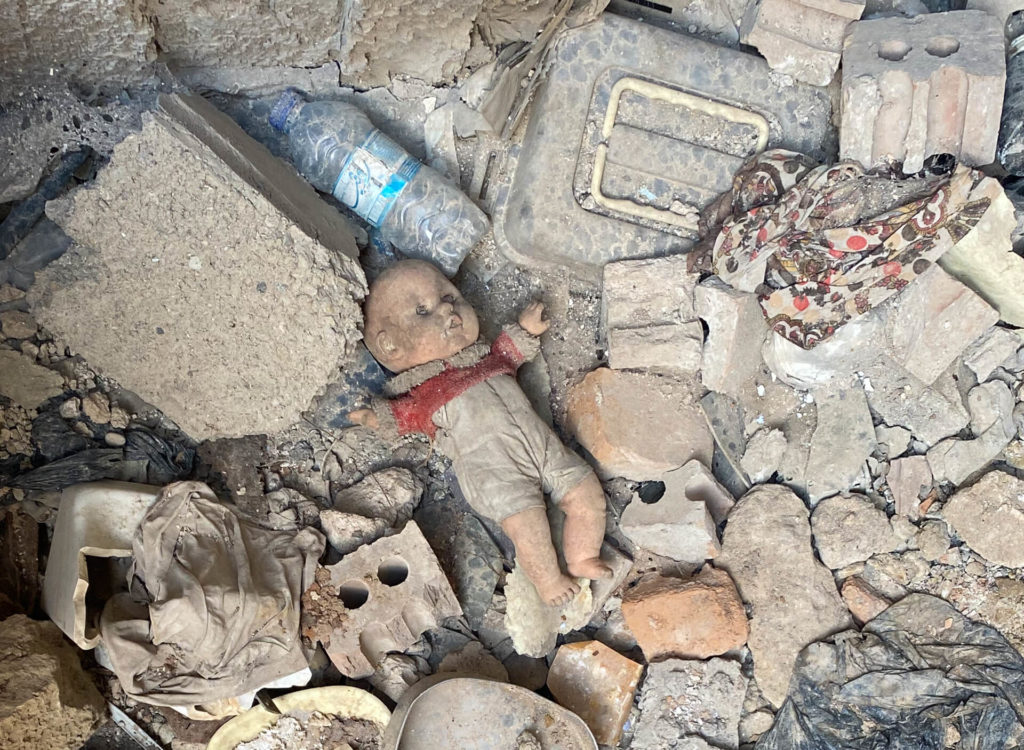
A child’s doll lies in the dust on the floor of a building that had been all but levelled by bombing.
Othman took us to visit the Umayyad Mosque, which was built in 638 AD, making it the oldest mosque in the whole of Mosul. Although badly damaged, it fortunately still stands. Until this point, Anna had not been wearing a headscarf (it was midday and extremely hot), but when we entered Othman asked her to wear one out of respect, which she did. After about two hours of wandering the devastated streets, we came to a single basement that was still occupied, with a man and some boys cutting wood, possibly for reconstruction. It is testament to the scale of the damage that, even after almost four years of peace, so few of the buildings are occupied.
Eventually, we left the devastated old town and headed back to the more modern areas, parts of which have already been rebuilt. We wandered the pretty local market and eventually stopped at a dessert shop. The owner spoke some English, so we chatted a bit. I wanted to try their traditional dessert (a kind of rice pudding), but the owner refused to take money for it (it was 1,000 IQD, about $0.69/€0.58), so I left the money on the counter. A couple of minutes later, I was sitting on the edge of the street nearby with Anna eating, when suddenly the owner came flying over and forced me to take the money back. “You are guests here,” he told me, “I cannot take your money.” This was just one example of the incredible hospitality that we encountered throughout our stay in Mosul.
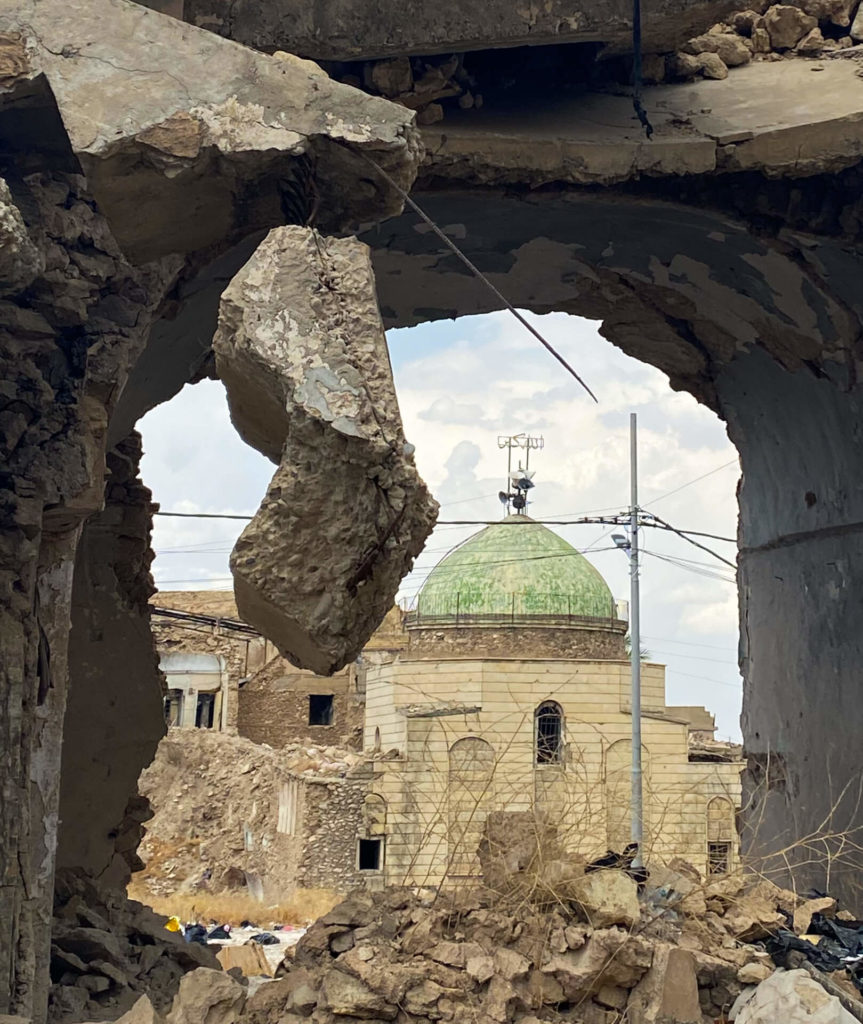
The beautiful green dome of the Umayyad Mosque, the oldest mosque in Mosul, built in 638 AD, viewed a gaping hold in a bombed-out building.
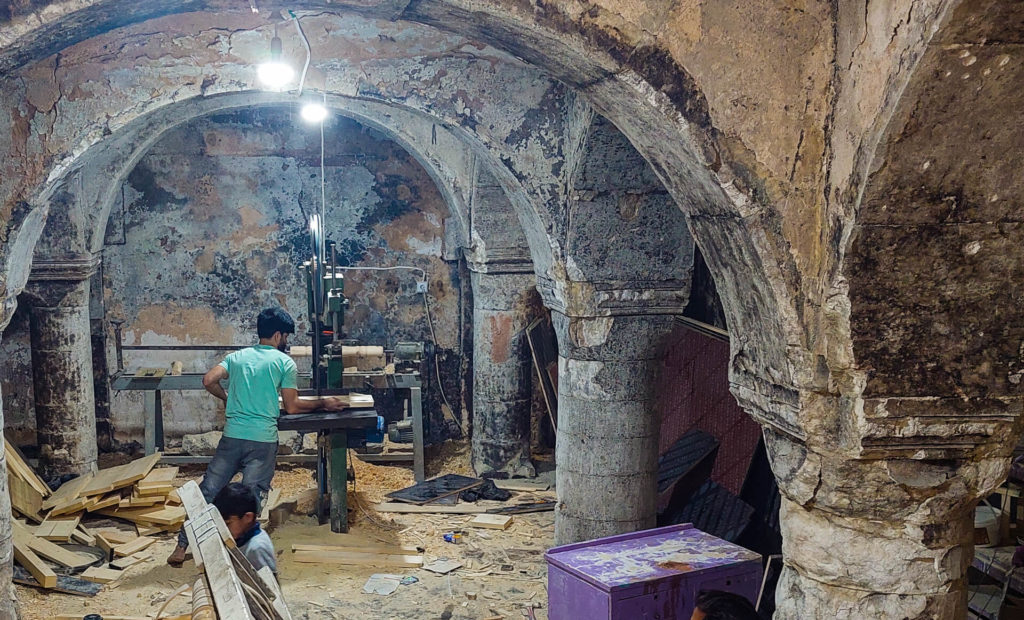
A boy cutting wood in a basement at the edge of the old town.
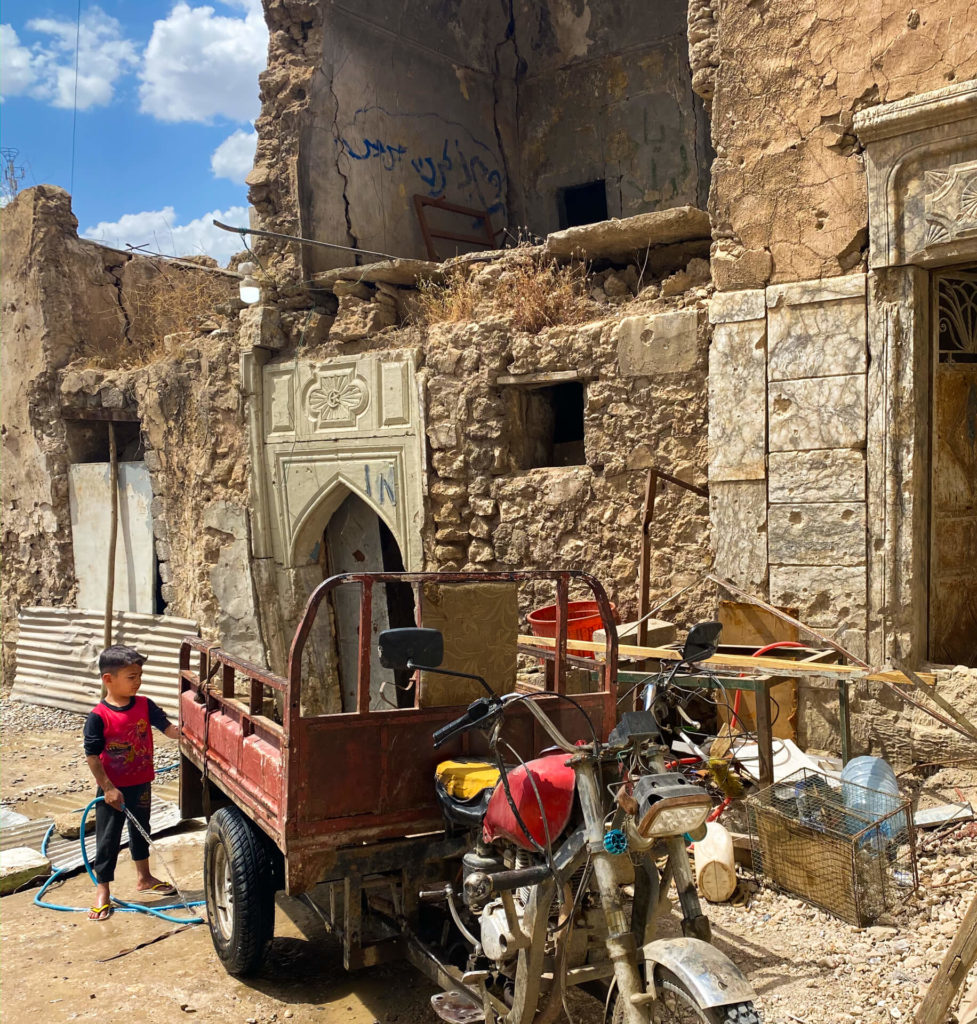
Life goes on – a child stands with a hose next to his father’s motorbike cart.
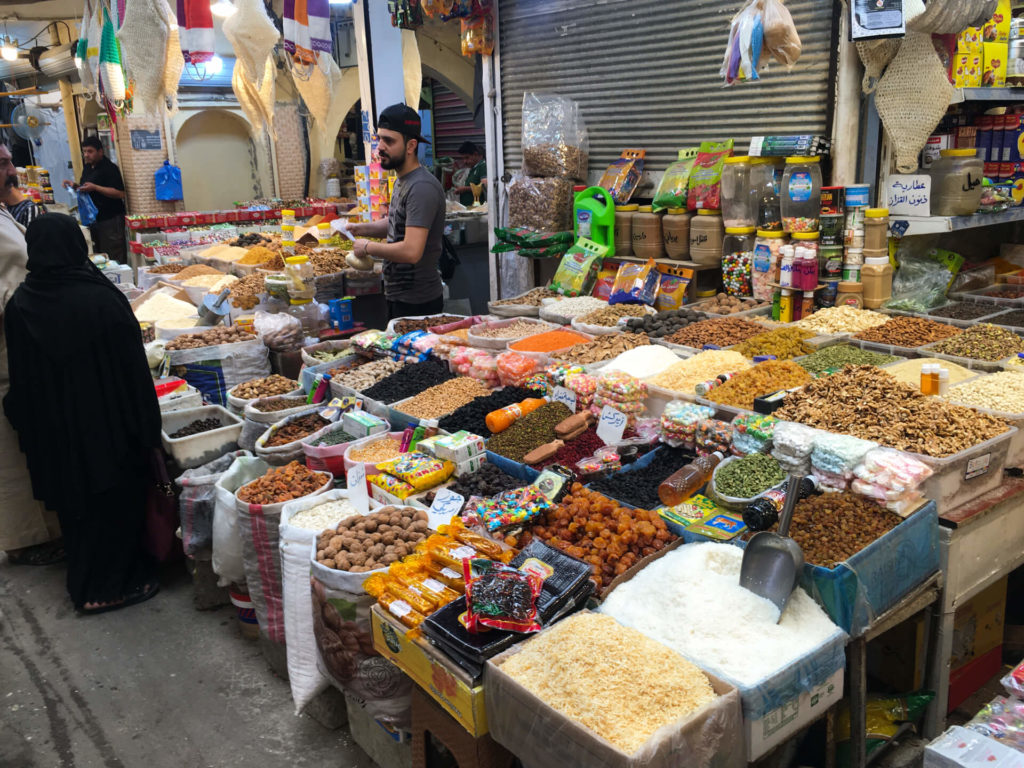
A vendor sells an array of colourful spices at a market in Mosul.
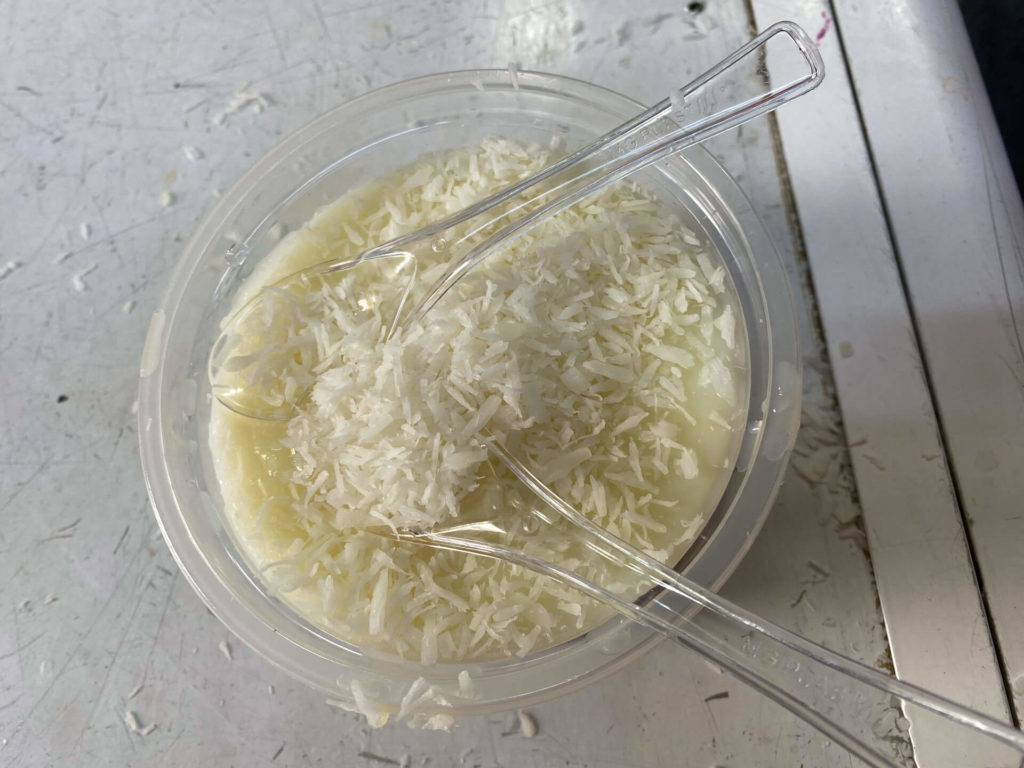
Rice pudding by the edge of the street – a classic and delicious Iraqi dessert.
After we finished exploring the city, Othman gave us a lift back to our hotel in his car. We stopped at the Mosul Grand Mosque on the way. The mosque’s construction was begun under Saddam Hussain, but never completed, and it was previously known as the Saddam Mosque. Construction restarted in 2019 with a $50m grant from the UAE. Even in its current incomplete state, it’s still an impressive building.
Mosul was one of the most interesting places I visited in Iraq, largely due to my interest in the country’s recent history. It’s amazing to see how the city is regenerating since ISIS was driven out and the courage of the local people. At the same time, it’s a sad reminder of recent events and the reconstruction effort that’s required to restore the city to its former glory is massive. I could easily have spent a few more days here, wandering the city and talking with local people.
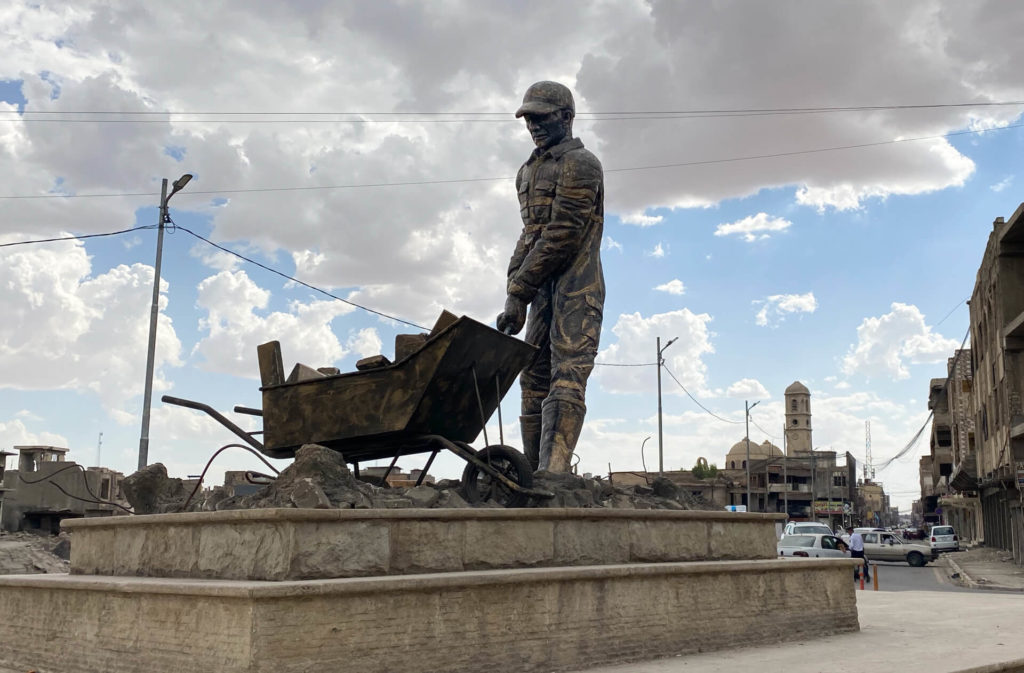
A statue to the hard work of rebuilding Mosul.
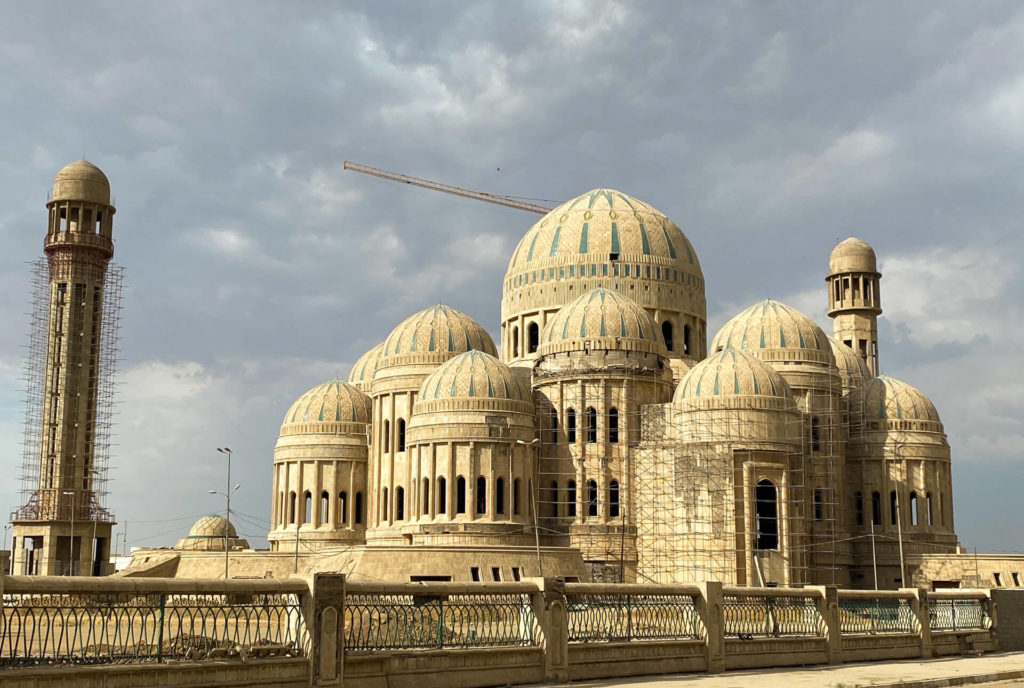
The impressive Mosul Grand Mosque currently under construction.
How to Visit Mosul and Hatra
- There are shared taxis to Mosul from Baghdad (25k IQD, about 4-5 hours from the Allawi North garage), Kirkuk (15k IQD, about 4 hours), Erbil (2-3 hours) and Dohuk ( about 2 hours). I’m not sure of the prices from Erbil and Dohuk, but it should be around 10-15k IQD per person.
- We stayed in the Al Sultan Palace Hotel and paid 60k IQD a night for a small suite for two people. It wasn’t great, but there were few options. Another hotel we tried first was the Hotel Royal VIP. It, in theory, had cheaper rooms (around 40k per night), but when we arrived they told us that they were not suitable for women. They also had suites for around 60k QID, but the ones at the Al Sultan Palace Hotel were nicer. Both hotels are in the same area and the main street nearby has quite a few options for food.
- Apart from accommodation, Mosul was the cheapest city we visited in Iraq.
- We experienced no problems, but it’s inevitable that some ISIS sympathisers still reside in Mosul and one other recent traveller did report aggressive behaviour from a local (a soldier intervened). To be on the safe side, it may be better not to go out alone in the areas near the old town at night.
- We stayed in a hotel on the left coast, because we were told by local friends that it’s safer than the right coast, where the old town is located. This is probably correct. However, the right coast is more interesting and I didn’t feel that it was particularly dangerous, so if I went back again, I would probably look for a hotel there instead.
- Some people, including Iraqis working in the tourist industry, told us that it’s not possible for foreigners to enter Mosul without a special permit. This is completely incorrect – we did it twice with no problems whatsoever.
- You cannot officially travel to Mosul on the Iraqi Kurdistan visa on arrival, as it is not part of the Kurdistan region. However, it is possible as a day trip from Erbil using a fixer. I haven’t done this, as I had a full Iraqi visa, but you can read about how to do it on the Against the Compass blog.
- When I visited Hatra, it was still completely impossible to enter unless you were lucky enough to meet someone with the right connections. However, it’s now generally possible to visit independently by hiring a taxi for a few hours in Mosul. The checkpoints are a bit hit and miss and you can get turned back if you’re unlucky, but since the beginning of 2022, many intrepid independent travellers have managed to get through. Hatra is a long way from the main road and public transport doesn’t go there, so taking a bus is not possible.
- Be sure to try Masgouf, delicious fish grilled with a selection of spices, while in Iraq. The locals say the best place is Nasiriyah, but you can find it in most major cities.

Masgouf is usually grilled on an open fire
A Quick Note to My Iraqi Friends
I try to tell the story of my visit to Mosul as I experienced it, the good and the bad, and give a balanced picture of how the city is today, at least from the point of view of a visiting foreigner. I know some of you will dislike the content of this article and especially the pictures of Mosul’s old town, the parts about my firing a gun in the desert and possible safety concerns. I have done my best to emphasize the positive aspects of my visit, and especially the friendliness of everyone I met. However, it would be unrealistic to show only this side and irresponsible not to mention safety concerns.
More About Iraq
If you’re thinking about visiting Iraq or just curious about how people do visit a country that, until recently, was completely off limits even to the most hardcore of travellers, check out my complete travel guide to Iraq. See my other articles on Iraq here:
Babylon: Visiting the Fabled City
The Fabled City of Babylon Babylon is probably the most famous place in the whole of Iraq, despite the fact that the hanging gardens are long gone. Archeologists aren’t even sure that they were actually in Babylon! However, the archeological site is impressive, as...
Samarra: Climbing the Malwiya Minaret
Samarra: Climbing the Malwiya Minaret The Malwiya minaret is one of the most iconic buildings in Iraq and was the highlight of my 3 week trip to the country. It’s beautiful, terrifying if you have vertigo and located in Samarra, a city not under the authority of the...

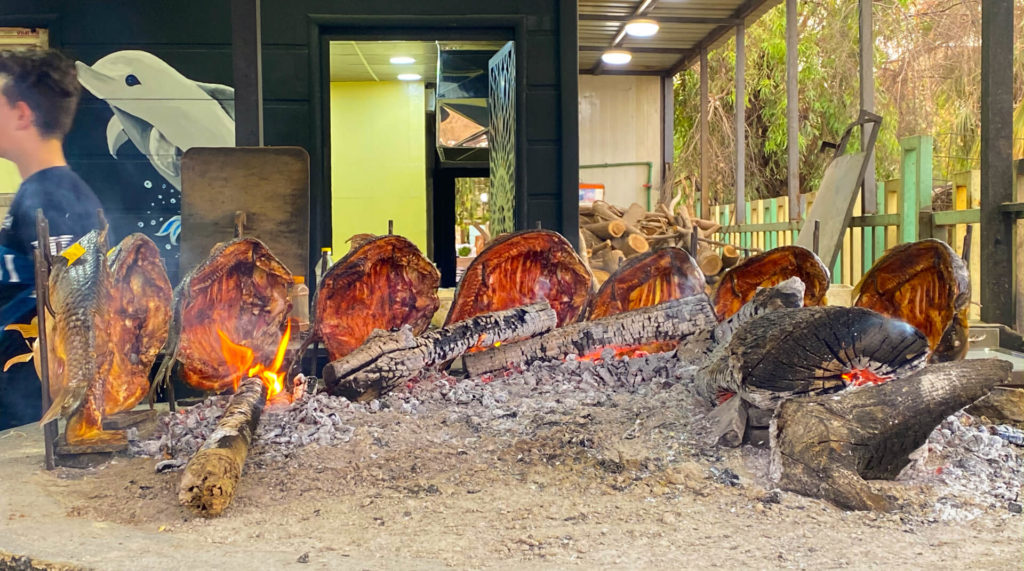
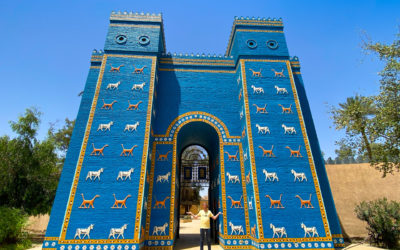
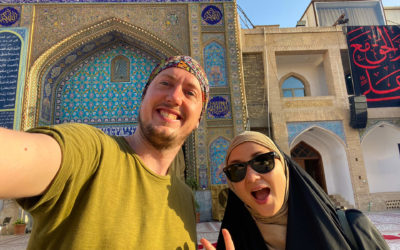
am looking for a knowledgeable guide to take me to ancient part of Mosul, Khorsabad, Nimrud, Nineveh, Hatra, Ashur (anything else??). Can you help me?
Many thanks
Suzanne Easton
suzanne.easton101@gmail.com
Sent from my iPad
Hi Suzanne. I travel independently, so aren’t so knowledgeable about guides. However, I suggest you join the Iraqi Traveller’s Cafe Facebook group (https://www.facebook.com/groups/754425071626757) and ask there. They should be able to recommend several.
Thanks Rowan for your answer which I have only just seen! I always travel independently b ut I was wary of doing that part of Iraq alone as an older woman who unfortunately does not speak the language even though I lived in Baghdad for 4 years! And I do not want to travel with a group, just with a knowledgeable guide who speaks the language.
Hi Suzanne. Honestly, Iraq is generally very safe. I know several female travellers who have been there independently. However, I do understand that you prefer to travel with a guide. I hope you find a good one and enjoy your trip.